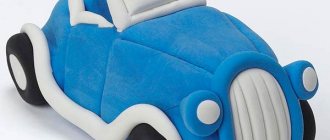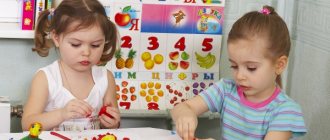List of used literature
Program from Birth to School
Similar works
Pedagogical conditions for teaching drawing to children 2-3 years old
Finalization of the client's order: Formation of the foundations of visual literacy in young children in painting with paint 3
Finalization of the client’s order: Formation of the basics of visual literacy in young children in painting with paint
formation of imagination in primary school children in lessons using folk toys 3
formation of imagination in primary school children in lessons using folk toys 2
Artistic and aesthetic activities in preschool educational institutions as a means of developing children’s creative abilities in fine art classes (drawing, older age)
Organization of work on teaching children of senior preschool age the technique of depicting folk ornaments in classes and in independent activities 2
Development of dialogical speech of middle preschool children using small forms of folklore
Development of dialogical speech of middle preschool children using small forms of folklore 2
How to draw a truck
First I want to offer a simple option. I think every parent will be able to show their child the drawing sequence, and then he will try it himself.
1. Using a simple pencil on a sheet of paper, draw two rectangles: a large one and a small one, like this.
2. Next we draw the upper part of the cabin and two wheels.
3. Draw small details on the cabin, wheels, headlights. Erase the extra lines.
4. If desired, you can color with colored pencils, felt-tip pens or paints.
The result is a cargo van like this.
The entire sequence of images can be viewed in the gallery by clicking on any picture, moving along the arrows to the right or left.
How to draw a truck step by step
The second option is suitable for older children. I will show you in detail step by step how to depict another truck.
1. To make it easier to draw, first draw thin horizontal lines at the same distance in the center of the sheet.
2. Draw the truck cabin, guided by the lines.
3. Add the body.
4. Next we draw the wheels.
5. Add additional body and cabin parts.
6. Draw the cabin, body, wheels, headlights. Erase the extra lines.
7. Color with whatever you like. We did it with paints.
The entire sequence of images can be viewed in the gallery by clicking on any picture, moving along the arrows to the right or left.
Now you know how to draw a truck and can show your child the whole process step by step. I wish you creative success and a great mood!
Read here how to draw a cat.
If this article was useful to you, please share it with your friends by clicking on the social media buttons.
Source
Table: summary of a drawing lesson by E. Sidorova on the topic “Passenger car”
| GCD stage | Contents of the stage |
| Preparatory stage | Purpose of the lesson: to introduce children to a passenger car, the history of its creation, and its purpose. Objectives: Teach children to draw passenger vehicles, convey the structural features of the car, adhere to the proposed sequence of a detailed image of the object. Strengthen your painting skills: apply strokes evenly in one direction without visible gaps, do not go beyond the contour of the finished silhouette. Develop compositional skills. Materials for work: A4 landscape sheet; a simple pencil; eraser; a set of colored pencils or wax crayons; drawings or photo illustrations depicting different brands of cars. Musical series: audio recording of the song “Dad bought a car”, music by A. Pugacheva, words by O. Milyavsky. Preliminary work: targeted walk to the roadway, stop, observation of passenger transport. Examination of drawings or photo illustrations depicting different brands of cars in free time. |
| Organizational part | The teacher asks the children to guess the riddle:
- Right. Children, we received an order from a car store; they sold out all the cars that were in stock. So the store director asked to replenish the showroom with new cars. |
| Main part | 1. Conversation about transport. — Now it is very difficult to imagine our life without cars. But there was a time when people traveled long distances on foot or on horseback. This took a lot of time and effort. The first car was clumsy and funny in appearance: in front there was a steam boiler with a smoking pipe, in the middle there was a driver’s seat, and the whole structure rolled on three wheels. The boiler was heated with wood, the water boiled in it, and steam was produced, which set the car engine in motion. The driver controlled the car not with a steering wheel, but with the help of levers. The car was driving very slowly, rattling loudly, snorting, whistling, which horrified passers-by. But at the same time, it also caused delight, since it moved on its own, not without reason receiving its name from two Greek words: “auto” - which means “oneself”, “mobile” - “movement”. Much later, a car was designed that no longer had a boiler or firebox; its new engine ran on gasoline. Nowadays there are many different cars. Cars differ in size, color, body type. But, despite the diversity, they all have a similar structure: they have a metal body - the basis of the car, headlights are attached to the outside of the body at the front, and lights at the back. Inside the body - in the cabin - there are seats for the driver and passengers, there is also a steering wheel, gear shift levers and all the instruments for driving the car. From the salon you can look out onto the street through the windows. In the front part of the body, under the hood, there is an engine, or otherwise called a motor. At the rear of the car there is a trunk for transporting cargo. The chassis is attached to the lower part of the body, otherwise it is called the chassis, it is like a cart with wheels that carries a small house on itself. Any car is equipped with a loud sound signal in order to promptly warn of its approach those pedestrians who are inattentive on the road. Reading the poem "Bi-Bi".
— A modern passenger car has everything to make traveling in it comfortable: a radio built into the dashboard, air conditioning, an autopilot that helps the driver control the car. Each seat is equipped with seat belts that save a person in the event of an accident. A passenger car can carry no more than three or four passengers at a time, not counting the driver. This is probably why the car is called a passenger car, since it is not large in size, carries few people and a minimum of cargo, that is, it travels light, unlike a heavy-duty vehicle. Passenger cars are most convenient for traveling to the country, to the store, to work. Physical school
2. Practical part. Stages of work execution. Children draw a contour drawing of a car with a simple pencil, relying on the teacher’s verbal explanation and his demonstration of techniques for detailed drawing of an object. The teacher reminds that you should always start drawing in the center (middle) of the sheet, the object should not be too small, but not too large, on the entire sheet, there should be free space around it to depict any additional objects, elements, so that it turns out a single thematic composition.
Warm-up for hands “Wind-up cars!”
3. Independent work of children. |
| Lesson summary | After the work is completed, the drawings are displayed for general review. - Children, you tried very hard, now the store’s showroom is full of new cars, and everyone can choose a car according to their taste and color. Or it may happen that your dad comes into the store and buys a car, and then takes you for a ride around the city. You can play an audio recording of the song “Dad Bought a Car” and invite the children to take a ride in their “little cars.” |
Content
Progress of the lesson.
1.Org. moment: Children stand in a semicircle. The teacher asks you to guess the riddle:
Educator: He is big and very heavy.
He's used to carrying loads
What kind of car is this?
Everyone knows - (Truck).
Educator: Children, let's look carefully in the group and find where our truck is hidden.
The children find a truck and sit in a semicircle on the carpet.
Educator: Well done!
2. Main part
Educator: Let's look at our truck.
Preview:
"People's Labor in Spring Tractor"
Spring has come. And a troublesome, responsible time has begun for grain growers and agricultural producers. They have to carry out all agricultural work on time, sow wheat, barley, oats, rye, and other crops. People's work in spring is special. Spring day feeds you all year long. A day earlier you sow, a week earlier you reap.
The snow will melt in a clean field,
Melt water will subside -
Runs behind the tractor driver
There is a furrow to the blue river.
The seeders will come out later
Sowing fields with grain.
During the winter, the ground was compressed under the snow and became hard. Seeds cannot be planted in such soil. Therefore, as soon as the snow melts, the tractor driver takes the tractor out to the field and begins to plow the land.
He plows so that the earth becomes soft and begins to breathe.
The tractor plows the ground using a plow that is attached to the rear. After the plow, large lumps remain, so that the field becomes smooth without lumps, it is loosened. A harrow is attached to the tractor. With the help of which the lumps are broken. To sow seeds, a seeder is attached to the tractor. The tractor driver performs a huge and important job. He works from early morning until late evening, because he needs to have time to sow all the fields during the spring months.
Pencil drawing diagram - a tractor with a plow.
Source





